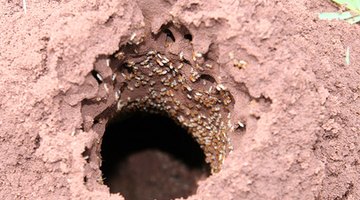Termites in Sheetrock
Termites don’t eat wood; they eat cellulose. Cellulose is the soft white carbohydrate inside a tree's trunk that forms the basic structure of the tree. The sheetrock in your home consists of plaster panels with thick sheets of paperboard containing cellulose on either side.

Drywood and subterranean worker termites consume the cellulose to feed colonies inside interior wood beams or under the soil around your home’s exterior. These workers can be active year-round in a heated building, eating away at the walls of your home and leaving visible signs that need immediate action when discovered.
Drywood Termites
Winged male and female drywood termites swarm and mate in late summer and early fall. The queen lays eggs in dry, cracked wood or in spaces between wood shingles. Reproductive termites stay inside the colony, protected by soldier termites. Worker termites leave the nest and eat cellulose material found in the sheetrock, which they bring back to the nest, leaving faint trail lines along the ceiling or wall. When they eat through the cellulose panel, they “kick” holes, pushing fecal material that looks like tiny grains of sand through the hole. Tiny pin holes in the wall, faint lines on the drywall marking a tunnel “map,” or a buildup of fecal material around the sheetrock are signs of infestation.
Subterranean Termites
Subterranean termites nest underneath the moist soil around your home’s exterior. Reproductive termites swarm and mate in the spring daylight after the rain. They return to the nest where the queen lays eggs. Reproductive adults stay in the nest, guarded by the soldier ants. The workers feed above ground, traveling through small, tubular mud tunnels made of soil, wood and saliva. These tunnels protect workers from ant predators and retain moisture in the nest. The blind workers travel along this “highway” to find food. They leave small pin holes in the dry wall at the end of the highway, but they fill the holes with dirt. They also excrete a bumpy, cardboard-type substance, leaving bumps in the trail lines on the ceiling or wall.
Damage
Termites do more than damage sheetrock. They also eat into the wood baseboard at the bottom of the wall. Because they need moisture, they often eat sheetrock panels around plumbing pipes and fixtures. Structural damage occurs when they eat through load-bearing walls that support the upper floor or roof of the house. If termites are eating through the sheetrock, they may also be eating through the wall studs or ceiling joists of your house. According to Pest Supply Home Choice, if you see signs of termite damage in your sheetrock, you should take action immediately.
Treatment
There is a process that uses the termites’ natural behaviors to cause the colony to "die of starvation." The process uses a baiting system to kill the workers responsible for feeding the colony. Pest Supply Home Choice, however, recommends immediate spraying of Termidor or Premise into the wall voids and exterior soil near the infested sheetrock before installing bait stations. This treatment is necessary because worker termites can cause extensive damage during the time it takes for them to find the bait and establish a feeding cycle.
The Drip Cap
- Termites don’t eat wood; they eat cellulose.
- Winged male and female drywood termites swarm and mate in late summer and early fall.
- Worker termites leave the nest and eat cellulose material found in the sheetrock, which they bring back to the nest, leaving faint trail lines along the ceiling or wall.
- When they eat through the cellulose panel, they “kick” holes, pushing fecal material that looks like tiny grains of sand through the hole.
- These tunnels protect workers from ant predators and retain moisture in the nest.
- Termites do more than damage sheetrock.
- If termites are eating through the sheetrock, they may also be eating through the wall studs or ceiling joists of your house.
References
Writer Bio
Based in Florence, Oregon, Brenda Duffey has been editing and writing educational articles since 1967. Her work has appeared in various online publications. Duffey's cross-country trip lesson plan appears in "Powerful Teaching," published in 2003. Duffey holds a Bachelor of Arts and Master of Social Work from the University of Louisville.
Photo Credits
- termites image by Christophe Fouquin from Fotolia.com
- termites image by Christophe Fouquin from Fotolia.com
More Articles



